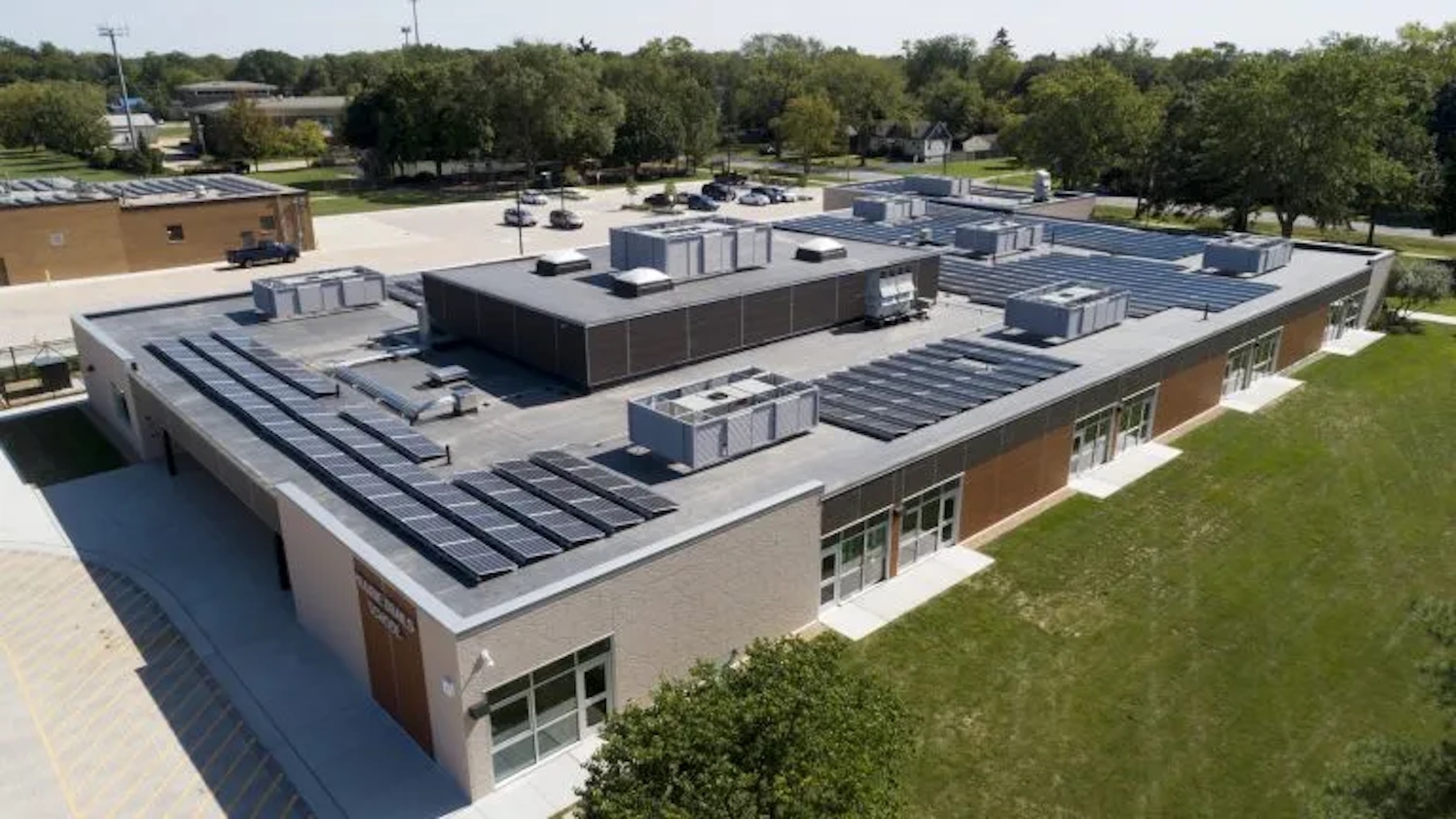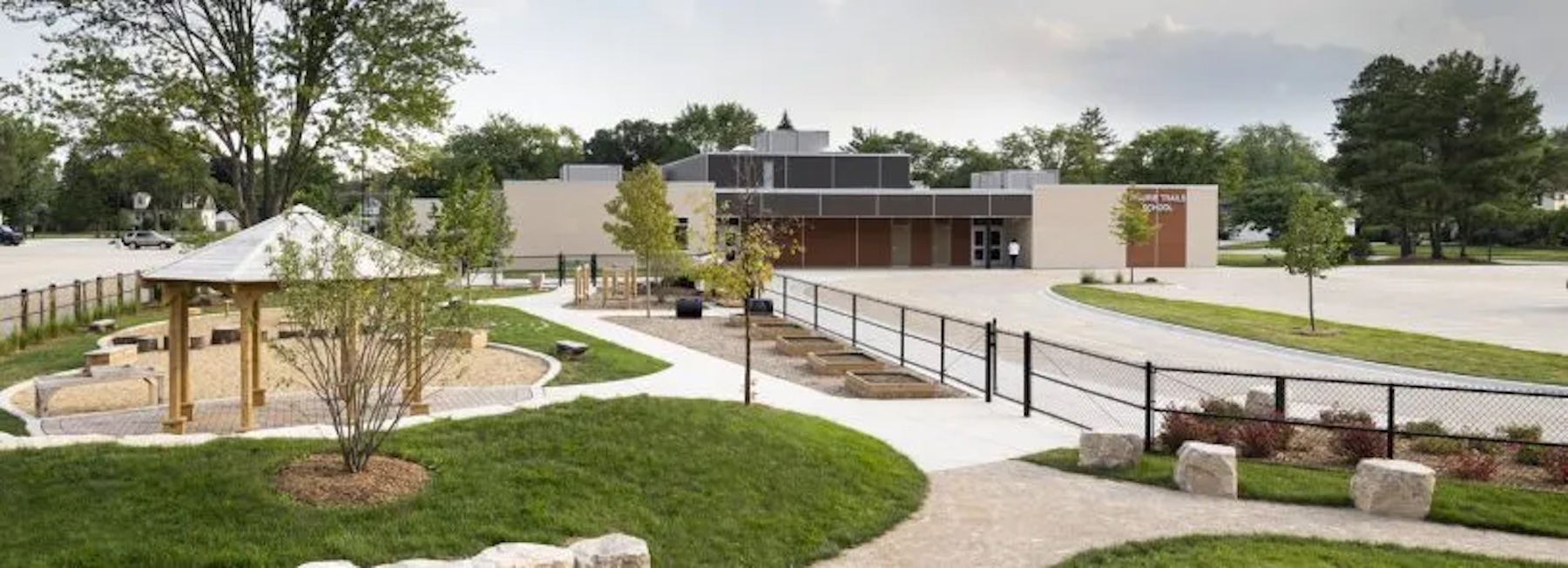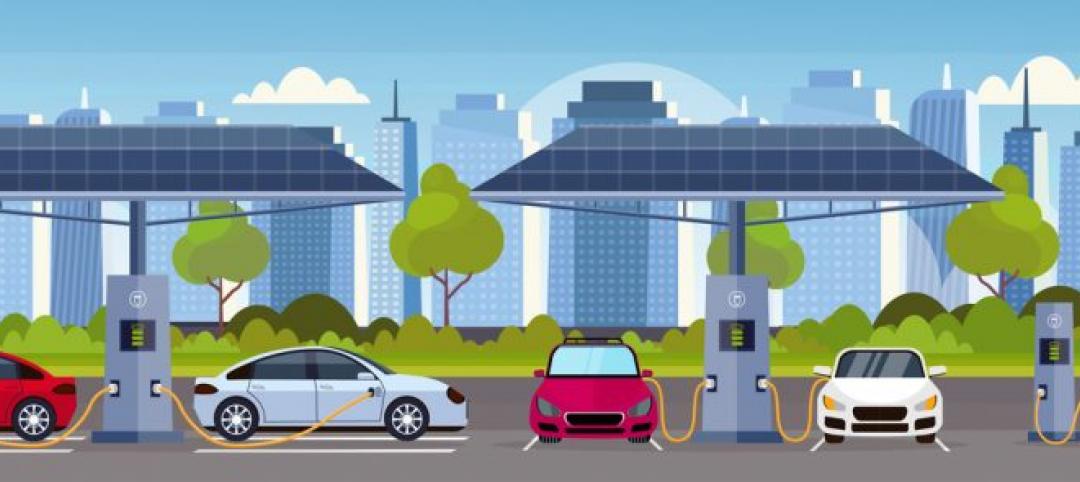Designing a net-zero energy building is always a challenge, but renovating an existing school and applying for grants to make the project happen is another challenge entirely. IMEG recently had the opportunity to do just that, delivering a school district’s first net-zero facility.
When the Park View Early Learning Center in Mount Prospect, IL, was chosen to house the River Trails School District 26 kindergarten, preschool, and administration office, it needed to be renovated for the first time since its construction in 1965. The facility’s failing systems and outdated infrastructure were no longer meeting the district’s needs, so it was redesigned and renamed Prairie Trails School. Following in the footsteps of other energy-efficient schools in the district—four of which earned ENERGY STAR® certification—the new early learning center was designed for optimized indoor air quality and building comfort.
IMEG evaluated various HVAC and envelope options after conducting an energy model of the existing building and testing strategies and their impact on energy use and operational costs. The team ultimately designed an extremely tight and energy efficient envelope and an all-electric HVAC system with a variable refrigerant flow system coupled with dedicated outdoor air systems that meet the Passive House requirements for energy-efficient and comfortable indoor spaces.
In order to offset the costs of the highly sustainable renovation, the school pursued a $2 million grant from the Illinois Clean Energy Community Foundation (ICECF), which requires the building to use net-zero energy. IMEG worked closely with FGM Architects, River Trail School District 26, Trane, and a Passive House consultant to predict energy use and how much electricity would be generated by the photovoltaic system, properly size the system, and then apply for the grant.
The school initially received half of the grant at the beginning of the project. The team is now tracking the energy use data and trends in the completed building—adjusting usage as needed to continue to consume less energy than the photovoltaic system produces—and prove that the building is net zero.
Other strategies employed to help the design achieve net zero include running the systems at a reduced rate when the building is unoccupied and keeping a strict schedule for the building automation systems. For example, the gymnasium systems run at a reduced rate not only when the building is unoccupied, but also during normal school hours when no students are in the space.
The school will receive the remaining grant funds once the design has proved to be net zero for a full year. Tracking began in March 2022 and is showing positive trends upon initial evaluation.

More from Author
IMEG Corp. | Jun 18, 2024
A healthcare simulation technology consultant can save time, money, and headaches
As the demand for skilled healthcare professionals continues to rise, healthcare simulation is playing an increasingly vital role in the skill development, compliance, and continuing education of the clinical workforce.
IMEG Corp. | Jan 11, 2024
Designing for personal technology is crucial for senior living facilities
Today’s seniors are increasingly tech savvy. It isn’t enough to give senior living residents a pre-determined bundle of technology and assume that they’ll be satisfied.
IMEG Corp. | Nov 10, 2023
3 important early considerations for office-to-residential conversions
Scott Campagna, PE, Senior Director of Housing, IMEG Corp, shares insights from experts on office-to-residential conversion issues that may be mitigated when dealt with early.
IMEG Corp. | Sep 28, 2023
Structural engineering solutions for office-to-residential conversion
IMEG's Edwin Dean, Joe Gulden, and Doug Sweeney, share seven key focuses for structural engineers when planning office-to-residential conversions.
IMEG Corp. | Jun 12, 2023
Drones take site assessments to new heights
Eric Vallejo, Director of Reality Capture and Geospatial Solutions, IMEG Corp., discusses strategies for using visualization and reality capture.
IMEG Corp. | Apr 20, 2023
13 trends, technologies, and strategies to expect in 2023
Biophilic design, microgrids, and decarbonization—these are three of the trends, technologies, and strategies IMEG’s market and service leaders believe are poised to have a growing impact on the built environment.
IMEG Corp. | Nov 16, 2022
SPC-4D: 7 reasons California hospital building owners should act now to meet seismic compliance
Seismic compliance with the applicable California building codes is onerous and disruptive for building owners, especially for a building in the heavily regulated sector of healthcare. Owners of older buildings that house acute care services have a big deadline on the horizon—Jan. 1, 2030, the cutoff date to upgrade their buildings to SPC-4D.
IMEG Corp. | Apr 19, 2022
6 trends to watch in healthcare design
As the healthcare landscape continues to evolve, IMEG’s healthcare leaders from across the country are seeing several emerging trends that are poised to have wide-ranging impacts on facility design and construction. Following are six of the trends and strategies they expect to become more commonplace in 2022 and the years to come.
IMEG Corp. | Feb 18, 2022
Crime Prevention Through Environmental Design: Comprehensive strategies to keep people and buildings safe
CPTED is so much more than surface-level protection; it encompasses multiple phases of design, social programs, colors, lighting, natural surveillance, natural access control, and even traffic curbing.
IMEG Corp. | Feb 1, 2022
Sustainable design solutions will power EV charging stations
As the EV market share has been recognized, MEP firms have been tasked with the responsibility of an entirely new design: charging stations.
















